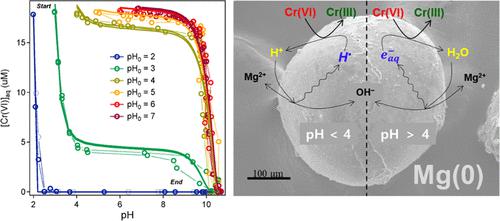当前位置:
X-MOL 学术
›
Environ. Sci. Technol.
›
论文详情
Our official English website, www.x-mol.net, welcomes your
feedback! (Note: you will need to create a separate account there.)
Modeling the Role in pH on Contaminant Sequestration by Zerovalent Metals: Chromate Reduction by Zerovalent Magnesium
Environmental Science & Technology ( IF 10.8 ) Pub Date : 2024-01-26 , DOI: 10.1021/acs.est.3c08367 Jaeseon Park 1 , Joel Z Bandstra 2 , Paul G Tratnyek 3 , Omar R Harvey 4 , Jong-Seong Bae 5 , Giehyeon Lee 1
Environmental Science & Technology ( IF 10.8 ) Pub Date : 2024-01-26 , DOI: 10.1021/acs.est.3c08367 Jaeseon Park 1 , Joel Z Bandstra 2 , Paul G Tratnyek 3 , Omar R Harvey 4 , Jong-Seong Bae 5 , Giehyeon Lee 1
Affiliation

|
The role of pH in sequestration of Cr(VI) by zerovalent magnesium (ZVMg) was characterized by global fitting of a kinetic model to time-series data from unbuffered batch experiments with varying initial pH values. At initial pH values ranging from 2.0 to 6.8, ZVMg (0.5 g/L) completely reduced Cr(VI) (18.1 μM) within 24 h, during which time pH rapidly increased to a plateau value of ∼10. Time-series correlation analysis of the pH and aqueous Cr(VI), Cr(III), and Mg(II) concentration data suggested that these conditions are controlled by combinations of reactions (involving Mg0 oxidative dissolution and Cr(VI) sequestration) that evolve over the time course of each experiment. Since this is also likely to occur during any engineering applications of ZVMg for remediation, we developed a kinetic model for dynamic pH changes coupled with ZVMg corrosion processes. Using this model, the synchronous changes in Cr(VI) and Mg(II) concentrations were fully predicted based on the Langmuir–Hinshelwood kinetics and transition-state theory, respectively. The reactivity of ZVMg was different in two pH regimes that were pH-dependent at pH < 4 and pH-independent at the higher pH. This contrasting pH effect could be ascribed to the shift of the primary oxidant of ZVMg from H+ to H2O at the lower and higher pH regimes, respectively.
中文翻译:

模拟 pH 对零价金属封存污染物的作用:零价镁还原铬酸盐
pH 在零价镁 (ZVMg) 螯合 Cr(VI) 中的作用通过将动力学模型与来自不同初始 pH 值的无缓冲批量实验的时间序列数据进行全局拟合来表征。在初始 pH 值范围为 2.0 至 6.8 时,ZVMg (0.5 g/L) 在 24 小时内完全还原 Cr(VI) (18.1 μM),在此期间 pH 迅速增加至~10 的平台值。 pH 值和含水 Cr(VI)、Cr(III) 和 Mg(II) 浓度数据的时间序列相关分析表明,这些条件是由反应组合控制的(涉及 Mg 0氧化溶解和 Cr(VI) 螯合)随着每个实验的时间进程而演变。由于这种情况也可能发生在 ZVMg 修复的任何工程应用中,因此我们开发了动态 pH 变化与 ZVMg 腐蚀过程相结合的动力学模型。使用该模型,分别基于 Langmuir-Hinshelwood 动力学和过渡态理论充分预测了 Cr(VI) 和 Mg(II) 浓度的同步变化。 ZVMg 的反应性在两种 pH 范围内不同,在 pH < 4 时与 pH 相关,在较高 pH 时与 pH 无关。这种对比的 pH 效应可归因于在较低和较高 pH 条件下 ZVMg 的主要氧化剂分别从 H +转变为 H 2 O。
更新日期:2024-01-26
中文翻译:

模拟 pH 对零价金属封存污染物的作用:零价镁还原铬酸盐
pH 在零价镁 (ZVMg) 螯合 Cr(VI) 中的作用通过将动力学模型与来自不同初始 pH 值的无缓冲批量实验的时间序列数据进行全局拟合来表征。在初始 pH 值范围为 2.0 至 6.8 时,ZVMg (0.5 g/L) 在 24 小时内完全还原 Cr(VI) (18.1 μM),在此期间 pH 迅速增加至~10 的平台值。 pH 值和含水 Cr(VI)、Cr(III) 和 Mg(II) 浓度数据的时间序列相关分析表明,这些条件是由反应组合控制的(涉及 Mg 0氧化溶解和 Cr(VI) 螯合)随着每个实验的时间进程而演变。由于这种情况也可能发生在 ZVMg 修复的任何工程应用中,因此我们开发了动态 pH 变化与 ZVMg 腐蚀过程相结合的动力学模型。使用该模型,分别基于 Langmuir-Hinshelwood 动力学和过渡态理论充分预测了 Cr(VI) 和 Mg(II) 浓度的同步变化。 ZVMg 的反应性在两种 pH 范围内不同,在 pH < 4 时与 pH 相关,在较高 pH 时与 pH 无关。这种对比的 pH 效应可归因于在较低和较高 pH 条件下 ZVMg 的主要氧化剂分别从 H +转变为 H 2 O。





















































 京公网安备 11010802027423号
京公网安备 11010802027423号